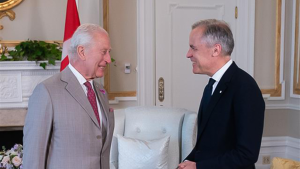Brett Lloyd wants to be an electrician, but he’s worried he may have to leave Ontario to pursue his career in the trade because he may not get hired on as an apprentice.
Brett Lloyd wants to be an electrician, but he’s worried he may have to leave Ontario to pursue his career in the trade because he may not get hired on as an apprentice.
“I have a degree from Laurier in Communications but this is what I want to do,” he says. “But the apprenticeship ratios in Ontario don’t make any sense.”
Similarly, Decc Electrical owner John Greco would love to hire more apprentices like Lloyd for his business, but his hands are tied by the same bonds: Ontario’s apprenticeship ratios which restrict hiring to one apprentice for three journeymen.
“We’re looking at expanding in Calgary where we have a job with five guys working and scaling back here,” says Greco. “The apprentice ratios are one-to-one there, so it’s easier to grow your business. You can be a 10-man company with five electricians. Here you can’t do that and you can’t get the journeymen because they’re retiring faster than we can train the replacements.”
Wayne Brunton of B T Electric Contracting in western Ontario sees the same issues, noting he gets all kinds of calls from young people but can’t hire them because of the ratios.
“I’ve got two apprentices now and I’d have to hire more electricians, but I don’t have the business for that,” he says, adding that he could go after more work and start to grow if he could use more apprentices with his qualified employees.
Brunton says he thinks the government is starting to listen, but it’s going to take a long time before anything changes.
“They’re pumping money into the apprenticeship programs, which is good, but there’s no jobs for these young people when they go to sign up because of the ratios; it’s a little backwards,” says Brunton.
Earlier this year, Mary Ingram-Haigh, president of the Ontario Electrical League, an association for non-union contractors, joined with the Canadian Federation of Independent Business to push Queen’s Park for changes to the ratios.
MPP Laurie Scott (PC- Victoria-Haliburton-Brock) tried to introduce a motion to get the ratio changed, citing a Daily Commercial News poll last spring showing 94 per cent of respondents wanted some adjustment.
So far there’s been no movement, but the campaign is making noise and, she says, gaining supporters, including Liberal MPPs.
“One-to-one ration is a standard outside Ontario,” she says, adding talks with the unions to discuss a compromise have been unfruitful.
Toronto and York District Labour Council president John Cartwright says there’s no hope of getting union support on reduced ratios.
“In the carpenters union it’s five to one, it varies by trade,” he says. “First, it’s a safety issue and we’ve seen that in areas like out west and in the U.S. south, where they have loosened things up, there are more accidents. And you don’t want a sudden influx of apprentices into the trades if there are not enough jobs for them.”
Like Lloyd, Ryan Richardson, 29, is also taking an apprenticeship pre-training program at the Pre-Apprenticeship Training Institute in North York and he worries about his future.
“I was laid off from a project management job and qualified for an Ontario second career training program which is paying for me here,” he says. “But when I’m finished, I don’t know whether I’ll get an apprenticeship. I went to the IBEW, but they told me sign-up wasn’t for several months and even then I could wait years.”
It’s a story Rick Krygsman hears over and over in his job as vice-president of Pro Electric in London, Ont.
“We get applications every week; these kids want to work,” he says. “But we can’t hire them because my apprenticeships are maxed out. Speaking for myself, it just seems wrong that the government is pouring money into programs but not letting companies hire the apprentices. What’s going to happen when those older experienced guys have all retired? We need to get more apprentices into the trades now because they need to work with those experienced hands to get that knowledge, otherwise we will lose it all. What makes it worse is that they’re talking about going to Europe to bring over skilled trades people when we’ve got people who want to work here.”
Greco agrees the split is along union and non-union lines, with the large international unions controlling growth and protecting the jobs of their members by limiting how many apprentices can be hired, knowing their lower salaries are attractive to businesses trying to hold the line on costs.
However, Joe Fashion, business manager of International Brotherhood of Electrical Workers Local 353, which represents 8,000 members working for 400 contractors, says there is already a one-to-one ratio in place for small shops.
“Right in the act, it says for each journeyman, a small contractor can have one apprentice, starting with one-to-one for those under two people, then three journeymen for two, three for five, up to eight journeymen for four apprentices,” he says.
Citing a report from the Construction Sector Council, Construction Moving Forward 2008 to 2016, Fashion says there were 23,415 electricians and apprentices in construction/maintenance in 2007 in Ontario. While the next couple of years will see continued demand — leading some to suggest we could face a skilled labour shortage — he says the report says things will start to slow in construction
The CSC also refers to a Statistics Canada’s Survey of Payroll Hours and Employment showing 79 per cent of specialty trade contractors (including electrical contractors) have nine or fewer employees, and 63 per cent have four or fewer employees, which he says covers the majority of contractors in Ontario.
“Too many apprentices flooding into the workforce could ‘destroy’ older electricians who would be pushed aside by contractors attracted to the lower wages,” he says.
The government is creating some pressure itself by pumping more funds into apprenticeships, he says, and that’s not a bad thing but it still needs to be handled properly, adding the bigger issue is to find out why one third of apprentices don’t complete their training.
Finally, says Fashion, the average age of an Ontario electrician is 40, which brings into question claims that experienced baby-boomer electricians are exiting into retirement at an alarming rate and could leave a knowledge vacuum.










Recent Comments
comments for this post are closed